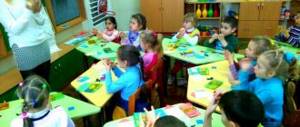Summary of a lesson in the senior group of a preschool educational institution on the topic “Signs of winter”
Summary of a lesson with older preschoolers on the topic: “Signs of winter.”
Age : senior preschool age. Goal : Repeat and reinforce the signs of winter, fun for children in winter. Expand your knowledge about the winter season. Develop speech, memory, logical thinking. Equipment: Pictures about winter, signs.
Progress of the lesson:
1. Organizational moment.
2. Solving the riddle: Listen to the poem by Afanasy Afanasyevich Fet. What time of year is this poem talking about? Justify your answer. Mother! Look from the window - You know, yesterday it was not for nothing that the cat washed her nose: There is no dirt, the whole yard is covered, It has brightened, it has turned white - Apparently, there is frost. Not prickly, light blue, Frost is hanging on the branches - Just look! It’s like someone with fresh, white, plump cotton wool removed everything from the bushes. 3. Work on the topic of the lesson: - Look at the pictures, what is drawn on them? (The pictures show: Children sledding, skiing, skating, making a snowman.) - What time of year does all this happen? (This happens in winter.) - What time of year is it now? (The season is winter.) - Today we will talk about the signs of winter. Who knows the signs of winter? Name them. 1. It became cold outside. 2. There is snow on the ground. 3. The rivers were covered with ice. 4. People wear warm clothes. 5. The trees are covered with frost. 6. Frost has set in. 7. It's snowing. 8. A snowstorm and blizzard are blowing. 9. Children sled, ski, skate, play snowballs, and make a snowman. -Who likes the winter season? Why? 4. Game “Is this true or false?” The teacher invites the children to listen carefully to the story about winter. Condition of the game: if children hear something that cannot be, they must clap their hands and say: “No, no, no!” In winter, the days are short and the nights are long. In winter, the days are long and the nights are short. (Clap.) It’s always hot in winter. (Clap.) In winter it is cold and frosty. In winter it rains very often. (Clap.) In winter it snows very often. In winter they wear sandals and Panama hats. (We clap.) In winter they wear warm jackets and fur coats, hats, and boots. 5. Outdoor game: “Hit the target.” (Snowballs are made from paper, you need to get into the circle drawn on the board.) 6. Explanation of proverbs about winter: 1. December ends the year, winter begins. (December is the last month of the year, the first month of winter.) 2. January is the beginning of the year, the middle of winter. (January is the first month of the year, the second month of winter.) 5. In the winter cold, everyone is young. (On a cold day, all people have a blush on their cheeks, so they appear young.) 4. A lot of snow means a lot of bread. (If a lot of snow falls during the winter, then in the fall they will harvest a large harvest of bread.) 7 Guessing riddles about winter and birds: 1. Without arms, without legs, but he can draw. (Frost.) 2. The tablecloth is white, it covers all the light. (Snow.) 3. Without arms, without legs, but he climbs into the hut. (Frost.) 4. Without hands, without an ax, a bridge was paved in the river. (Ice.) 5. On the trees during the day, he skillfully hammers the bark with his beak. (Woodpecker.) 6. They say they are thieves, These gray babies. Both noisy and pugnacious. Everyone is chirping - Whose are you, whose are you? (Sparrows.) 7. Her chest and neck are blackish. Her head, tail and wings are blacker, - That’s what a screamer is like. (Crow.) 8. This motley bird would pass for a crow, with the difference, guys, that it is white on the sides. (Magpie.) 9. Game: “Make a snowman.” (With your eyes closed, make a snowman out of plasticine.) 10. Summary of the lesson: - What did they talk about today? - What time of year? — Name the signs of winter. — What did you like about today’s lesson? — What interesting things did you learn?
We recommend watching:
Summary of a lesson on the surrounding world for the senior group “Hello, Zimushka-Winter!” Summary of a lesson for older preschoolers “Hello, winter - winter” Summary of GCD in the senior group: How animals prepare for winter Summary of GCD on cognitive development in the senior group on the topic: Winter
Similar articles:
Summary of a lesson in the senior group on the topic: Winter quarters of animals
Summary of a lesson in the senior group on the winter theme “Winter Fun”
Summary of the lesson “Birds in winter.” Senior group
Summary of a lesson on ecology in the senior group in kindergarten. Birds in the forest
Summary of a music lesson in kindergarten in the senior group on the topic: Winter
Consultation for parents of preschool educational institutions. Winter walks with children 5-7 years old
Consultation for parents of preschool educational institutions. Winter walks - observations with children of senior preschool age. Signs of winter with presentation
Author: Pavlova Vera Valerievna, teacher of the group with TNR, Municipal Educational Institution "Bendery Kindergarten No. 9", Bendery Description: The materials of this consultation will be useful for teachers of preschool educational institutions, used in work with parents Purpose: drawing up recommendations for parents on familiarizing themselves with the signs of winter on walks with preschoolers Tasks: - tell parents about the benefits of winter observations on walks with preschoolers - promote educational walks for parents with preschoolers in the winter The long-awaited winter has arrived. All nature changed very quickly, especially if everything around is covered with snow. The dense forest became covered with a snow-white blanket, the rivers and lakes were covered with a thick layer of ice, all insects completely disappeared, migratory birds flew away to warmer climes in the fall. All these signs of the coming winter are understandable to adults. The preschooler needs to show them and observe them with him.
The great benefits of observation. Nature surrounds people everywhere: whether you walk past the park to work, whether you are walking around the city with your child, or whether you went to the village to visit your grandparents in the summer. Involve your child in observing natural phenomena, because it is so exciting, educational and interesting. Many parents think that observing nature is boring and frivolous. Today, parents believe that a child in preschool should master reading, counting objects, know numbers, signs, be able to highlight unnecessary things and speak competently and clearly. These target guidelines, of course, are important for preschoolers, but it is observations that help preschoolers learn new things about nature, make comparisons, then conclusions, find the cause and result of an action. In addition, when observing objects of nature, a child develops feelings of respect and care, which is much more useful and important than learning to count and write at three years old. It is observations of nature that will help raise your child to be moral, able to treat everything that surrounds him with care and respect.
Today, preschoolers living in the city spend very little time in nature, and there are fewer and fewer natural objects themselves, such as parks and squares, left in cities. Parents tell preschoolers about the seasons, natural phenomena during these seasons, show videos, films, books with objects and natural phenomena. All this is certainly necessary. However, preschoolers prefer to see, feel, and only then remember for a long time. It is interesting for a preschooler to go with his parents to a winter forest or city park to see for himself the beauty of the surrounding nature and natural phenomena, to consider those magical signs of winter. At the same time, the adult asks questions, helping the child develop curiosity and search for answers to numerous questions. Dress warmly with your child, take a camera and a good mood, and go for a winter walk.
About the signs of winter. The very first observation, of course, is about what has changed in nature in winter - about the signs of winter. Even a 4-5 year old preschooler already has experience and some knowledge about winter signs. Any preschooler will answer that there is snow only in winter.
Why does it snow in winter? Only in winter it is very cold outside. Snowflakes in a cloud are frozen droplets of water. In summer and spring, rain falls from a rain cloud onto the ground; in winter, the clouds turn into snow, and at low temperatures, snow falls from the clouds. Allow your child to pick up a snowball and watch how the snow turns into water from his hot palm. Together with your child, collect snow in a bucket and bring it to the apartment. See that after a while the snow will melt and turn into water. Freeze this water in the freezer, let your child see that ice is also water. You can add bright gouache paints to the water, then the ice pieces will become multi-colored. If you go for a walk with your child during a snowfall, you may see falling snowflakes on your clothes or mittens. Tell your child that snowflakes consist of six rays, they are not similar to each other, if it is frosty outside, the snow creaks and crunches precisely because many rays from the snowflakes break. At home you can find photographs of snowflakes and show them to your child.
Let your child see that all snowflakes can be of different shapes, different sizes, but each has six rays. You can also make paper snowflakes at home with your child. Preschoolers really enjoy working with paper and scissors, and they will also learn how to cut out paper folded in two or four times. You can talk to your child about why it is cold in winter. To do this you will need a globe and a table lamp. Turn into astronomers by telling your child that the Earth is tilted and the Sun does not heat the Earth equally. If it is summer on one half of the planet, then winter comes on the other. When the Earth passes half a circle around the Sun, where there was winter, summer comes, and where there was summer, winter comes. You can also make figures of children in winter and summer clothes, placing them on the globe.
All people, at any time of the year, wear certain clothes, shoes, and protect their heads with hats. On a frosty day, you can talk to your child about winter clothes, shoes, hats and look through the window at what passers-by are wearing and wearing on the streets. The child will see the difference in the clothes and shoes of adults and children.
Undoubtedly, winter is a wonderful time for hardening and sports. Introduce your child to the most interesting winter sports, go to a skating rink, a hockey match, introduce your child to the fact that you can be healthy and cheerful even when it’s winter outside.
When it snows, you can see snow removal equipment on city streets. Together with your child, watch her work, talk about the benefits of snow for plants, as well as the help of this technology for people’s lives and the functioning of transport in the city.
Your child has probably noticed that in winter the days are shorter and the nights are longer. You can tell him that in the fall you returned from kindergarten and the sun was still shining, and in winter you come to kindergarten and it’s twilight outside, you leave kindergarten and it’s also twilight outside. Thus, even the winter season provides excellent material for observations with your child. Observe, learn new, interesting things, compare and draw conclusions.
Successful educational walks with your child!
Presentation on the topic: Consultation for parents of preschool children “Winter walks - observations. Signs of winter"
We recommend watching:
Consultation for kindergarten parents. Feed the birds in winter Consultation for parents of the younger group. How to organize children's leisure time in winter How to properly dress a child for a walk in winter Consultation for parents in kindergarten. Winter walks - observations with senior preschool children
Similar articles:
Outdoor winter games for children, 2-4 years old
Knowledge that must be formed
During the lesson, children should be asked to talk about the signs of winter in their area. They can be different: students in the Krasnodar region will say that stable snow cover may not be established at all; children from schools in the Murmansk region will note that in November the first signs of winter appear. The day when cold winds blow may occur in October, December, or January (depending on the region).
In such a lesson, the following concepts must be explained:
- blizzard, blizzard, blizzard;
- black ice;
- thaw;
- frost.
The period that begins with the winter solstice and ends with the vernal equinox is called astronomical winter. Residents of the Northern Hemisphere count the time from December 22 to March 21, and the Southern Hemisphere - from June 22 to September 21. Astronomical winter almost coincides in time with the period that was considered winter in ancient times in Rus' - from the Nativity of Christ (December 25, old style) to the Annunciation (March 25, old style).
Winter signs in living and inanimate nature for spring and summer
Folk signs of wildlife
By the behavior of nature in winter, you can find out what summer or spring will be like and when they will come. The winter cold quickly gets boring and people look forward to warmer days. Therefore, there are a lot of winter signs in living and inanimate nature for spring and summer:
Folk signs
It is always interesting to study omens, and it is very funny to observe the behavior of nature, especially if the omens come true.




